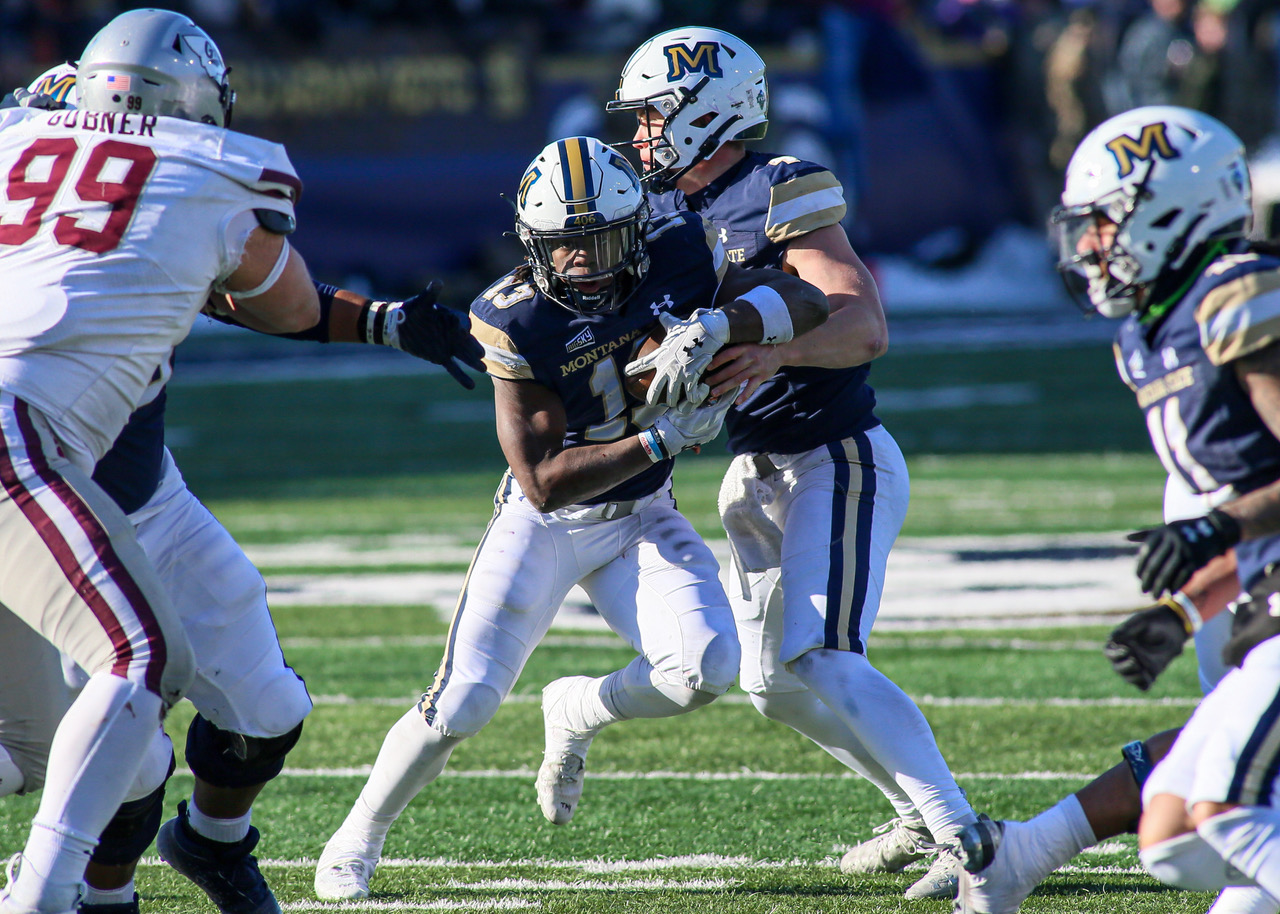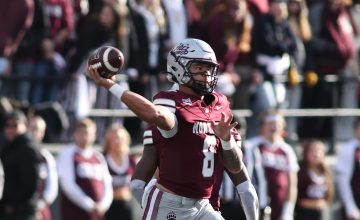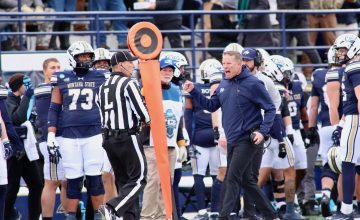The first month of the 2022 football season, many Montana State football observers have been wondering why – with so many injuries to running backs – the Bobcats haven’t been using Elijah Elliott more exclusively this season.
After all, a year ago Isaiah Ifanse was taking the bulk of the carries, so it would only make sense – considering the circumstances – that Elliott would fill that role.
The makeup of the team last year was much different. The team dynamic change dramatically when Tommy Mellott took over at quarterback going into the 2021 FCS playoffs. The Bobcats added another running quarterback in Sean Chambers in the off season and MSU has simply used more players as ball carriers out of the backfield as second-year offensive coordinator Taylor Housewright’s attack has put a higher priority on the horizontal nature of the run game.
This year, no one on the Bobcats has been a glue player any more than Elliott. He helped hold the Bobcats together by having two of his top three rushing games occur in the most harrowing games of the season – a 38-35 win over Eastern Washington and a 41-38 win over Northern Arizona. The third was against rival Montana. He’s taken over the position the past three weeks with 307 yards on 41 carries (7.5 per rush) with Ifanse yet to make his way back to the lineup, Lane Sumner suffering a season-ending injury and slashing wide receiver/tailback Marqui Johnson also emerging.
For the season, Elliott has run the ball 107 times for 676 yards (6.3 yards per carry) and has 10 receptions for 105 yards. He’s show flashes of being the star in a Bobcat rushing attack that’s piling up more than 300 yards per game entering Saturday’s second round FCS Playoff game against Weber State.

“Elijah had his best game against Montana,” MSU head coach Brent Vigen said, referring to Elliott’s 18-carry, 126-yard performance in the Bobcats’ 55-21 beat down of their rival on November 19.
“It’s the hardest he’s run. It’s the most tackles he’s broken. For him to ride this wave, which initially started with him way down the depth chart and not knowing when his opportunity was going to come. Ultimately, we went out to Oregon State and were playing with two QBs in mind more than we were playing with running backs. Got into conference play (vs. EWU) and he made the most of an opportunity that day and has continued to do so.
“Just appreciate him hanging in there because, if we don’t have Elijah Elliott and his consistency throughout the course of the season, then I’m not sure exactly where we’d be.”
His teammates are excited about the recent prowess of the 5-10, 195-pounder who has put on 20 pounds since the end of the 2021 season.
“I love the way he runs; he runs hard,” says tight end Treyton Pickering. “He’s really shifty, he’s always keeping his legs going. He super fun to block for. He hits the holes really hard. I just love him, his attitude’s great. I just love the way he holds himself for sure.”
What MSU has been doing in 2022 running the ball truly makes your head spin. Some like to simply refer to it as the “plus-1 run game.” To the layman it’s just looks like “keep-them-guessing.” Whatever you want to call it, it’s topping the already very successful rushing attacks the Bobcats have put out the past six seasons.
Plus-1 means using the quarterback as an extra running option and hence adding a blocker to your rushing attack. With the Bobcats using quarterbacks Tommy Mellott and Sean Chambers in that role with incredible success, MSU’s offensive coaches (Housewright, offensive line Brian Armstrong, running backs Jimmy Beal and wide receivers Justin Udy) have had a heyday in 2022 with a run game that looks nothing like it did at the end of the 2021 regular season.

“Our identity is more clear, I do think we have a wide variety of playmakers,” Vigen said. “It’s good, it’s complicated, too. You gotta figure out a way to get them all the ball. Last year if it wasn’t (wide receiver) Lance (McCutcheon), it was Isaiah (Ifanse). If it wasn’t Isaiah, it was Lance. That’s really what it was through the course of the regular season.
“We’re forcing defenses to defend so much more field now. That’s the width of the field and it can still be the length of the field at times. We mask things and disguise things, whether it’s with motion or who we’re giving the ball to, it complicates things for the defense. It’s an evolution of our offense for sure and a continued evolution for Taylor (Housewright).”
A year ago, the Bobcats ball dispersion wasn’t very random. It was mostly Ifanse with regular season starting quarterback Matt McKay and Elliott sprinkled in. Ifanse had 280 carries (20 per game) in 2021, while McKay had just 78 and Elliott 62. Once the playoffs started and McKay was replaced with Mellott, that ratio changed drastically, and the results were eye-popping.
Mellott would carry the ball 77 times – almost exactly as many times as McKay – in the postseason alone, yet much more effectively. MSU went from a very good running team to a great one despite Ifanse playing through injury. It’s ability to keep teams guessing, along with Mellott’s quantumly better running ability over McKay’s, brought the Bobcats from a team that stumbled into the playoffs before surging into the FCS championship game.
That success brought on a sea change to how Vigen would approach the 2022 season. For insurance, he brought in Chambers in the offseason – a move that paid dividends just four games in when Mellott went out for the better part of three games with a concussion. By the time Chambers had finished his first start at MSU – a 200-yard rushing/200-yard passing masterpiece against UC Davis – those many observers were trying to wrap their heads around just what the Bobcats were riding.
Elliott, meanwhile, had been filling his role masterfully while Mellott and Chambers were wowing the nation. When Chambers replaced Mellott at Eastern Washington and guided the Bobcats to a thrilling 38-35 comeback win, it was Elliott that was keeping MSU within striking distance.
“You love to see growth in kids,” Housewright said. “As a person and on the field. I couldn’t be more proud of him, he’s a great young man. Seeing him ultimately take the reins and go out there and prove himself was pretty awesome. That’s what you want, right? When guys get their opportunity, you don’t skip a beat and you just keep playing football and that’s what they did.”
After just seven carries and 35 yards through the first three games, Elliott started the contest with an electric answer to EWU’s fast opening score with a 45-yard touchdown run that bought the defense some time to settle in. His 18 carries for a season-high – to date – 156 yards on the day nearly went unnoticed with Chambers gaining 160 and scoring the game-winning touchdown in the waning minutes. That all came when the defense forced a clutch turnover after MSU failed to score moments earlier. Both players ran for key first downs as MSU ran out the clock to keep the ball away from EWU’s offense.
Elliott would total over 100 yards (74 rushing; 37 receiving) a week later against UC Davis, the same game Chambers had his 200/200, five total touchdowns effort. He followed that with 68 rush yards against Idaho State, then had just 36 yards in consecutive games against Northern Colorado and Weber State when Mellott burst back onto the scene after nearly three games off.
As was the case against Eastern Washington, Elliott came through with one of his best efforts on the season when the Bobcats found themselves in a 41-38 slugfest win over Northern Arizona. He rattled off 92 yards on 16 carries, including a key first down run to give MSU a brief lead and then a 17-yard run to the goal line that set up a chip-shot, game-winning field goal in the waning seconds – a play lost in the wake of Mellott’s huge pass to Taco Dowler that may be the play of the year for the Bobcats.
Elliott played a key role in getting the Bobcats off to their hot start against the Grizzlies when he had runs of 20, 9, 21, and 7 yards on MSU’s first eight plays of the game as the Bobcats jumped out to a 14-7 lead by running the ball on 13 straight plays. He would finish with 126 yards rushing.

MSU would throw just one pass out of its first 32 plays of the game. Elliott had seven rushes for 78 yards during the stretch that saw MSU use five different ball carriers.
“That’s what we’ve challenged him with is to run harder and make people miss,” Housewright said. “I thought Montana was his best game. I saw him run fearless, take care of the ball, get extra yards, and finish runs. That’s what you love to see.”
With 676 yards this season, Elliott is third on the team in rushing behind Mellott and Chambers and 11th in the Big Sky Conference. The Bobcats have six ball carriers with between 246 (Garrett Coon) and 856 (Mellott) yards. Chambers has 808, Lane Sumner 450 and Marqui Johnson 403. Coon and Johnson have collected almost all their yardage coming in the past three games, while Sumner has had to deal with two significant injuries.
The No. 3 ranked Bobcats (10-1) will host No. 9 Weber State (10-2) this Saturday in a second round FCS playoff game at 1:00 in Bobcat Stadium.














